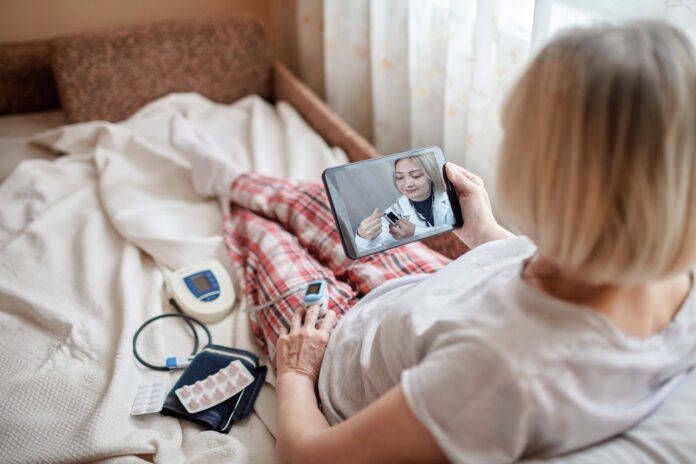Healthcare is an ever-evolving field, constantly adapting to technological advancements and changing patient needs. Among the numerous innovations, virtual wards have emerged as a transformative solution to some of healthcare’s most pressing challenges. Offering hospital-level care in the home environment, virtual wards are proving to be a game-changer in relieving hospital pressure.
This article will explore what virtual wards are and how they are alleviating pressure on hospitals while highlighting the invaluable contributions of nursing staff.
Understanding virtual wards
Virtual wards aim to provide a cohesive blend of remote and in-person care, integrating healthcare services seamlessly.
The concept
Virtual wards serve as an innovative bridge between modern technology and traditional healthcare. They essentially replicate the attentive environment of hospital wards, but with one distinct advantage: the setting is the comfort of the patient’s home. By harnessing the power of telehealth technologies, healthcare professionals can monitor, diagnose, and provide treatments to patients in real-time, regardless of the distance between them.
This unique system is especially beneficial for individuals who don’t necessarily need the infrastructure of a hospital but still require vigilant medical supervision. Whether it is chronic disease management or post-surgical monitoring, virtual wards are reshaping the healthcare landscape, offering care that is both efficient and patient-centered.
Who manages them?
Nursing staff, especially those with higher-level qualifications like a DNP-PNP, are instrumental in the effective operation of virtual wards. For nurses interested in these higher-level qualifications, Baylor University offers a course for Doctor of Nursing Practice – Pediatric Nurse Practitioner track (online DNP PNP) which prepares actively practicing Registered Nurses (RNs) to provide primary and acute care to pediatric patients in a variety of environments.
The roles of these nurses are multifaceted and crucial for the success of this innovative healthcare model. Not only do they coordinate a patient’s care plan, encompassing medication schedules, symptom monitoring, and regular updates to physicians, but they also perform remote check-ups using telehealth technology.
As the go-to professionals for initial medical consultations, they offer immediate support for any arising healthcare concerns. This sets the stage for a smooth transition from in-hospital care to home-based treatment. Their expertise and continual oversight assures both patients and their families that they are in capable hands, bridging the gap between traditional hospital environments and the evolving world of virtual care.
Advantages of virtual wards
Virtual wards are proving advantageous for both healthcare providers and patients, offering a range of benefits from social care to administrative efficiency. As technology continues to advance, the potential for virtual wards to revolutionize healthcare is significant.
Freeing up bed space
Virtual wards allow hospitals to focus on treating patients who require immediate and intensive care, thereby freeing up much-needed bed space. This has the added benefit of making room for emergency cases and reducing overall hospital congestion.
Taking pressure off staff
In a hospital setting, nurses and doctors must juggle multiple tasks and patients simultaneously. Virtual wards enable healthcare staff to manage patients more efficiently, thus reducing workload and stress.
This also means they can cut down on extensive paperwork and administrative tasks, allowing healthcare workers, especially nurses, to focus on patient care. This is particularly helpful for those in advanced roles, who can utilize their specialized skills more effectively.
Enhancing social care
Virtual wards offer the opportunity to integrate social care into healthcare delivery. Nursing staff can collaborate with social workers to ensure patients get medical care and assistance with daily living activities, emotional support, and community resources.
Making patients comfortable
Getting medical attention while at home generally enhances the patient’s overall wellbeing and comfort. This benefit is particularly noticeable in pediatric settings, where healthcare providers find it easier to connect with and treat children when they are in a familiar space.
Technological advancements
With the rise of wearable health tech, real-time data analytics, and Artificial Intelligence (AI) driven monitoring systems, virtual wards are becoming technological marvels. These advancements are not merely incremental but transformative, setting the stage for more effective, timely, and personalized healthcare.
Wearables, for example, allow continuous tracking of vital statistics, while real-time data analytics help in proactive decision-making. AI algorithms can even predict health events before they happen, such as potential falls or medication interactions. All these technologies contribute to making virtual wards increasingly efficient, reliable, and a preferred option for healthcare in the coming years.
Policy implications
Governments and healthcare organizations are recognizing the tremendous potential of virtual wards in transforming healthcare delivery. In response, there is a growing push to create comprehensive policies that not only permit but actively support the integration of virtual wards into mainstream healthcare systems. From reimbursement frameworks to quality control standards, efforts are being made to standardize and facilitate this healthcare model. The aim is to ensure that virtual wards become a viable, sustainable, and universally accessible healthcare option for the future.
The nursing perspective
Nursing professionals are not just participants but are emerging as leaders in the development and management of virtual wards. Their deep understanding of patient care, combined with technological savvy, positions them as key players in the successful implementation of this innovative healthcare approach.
Nurses are taking on roles that span from patient coordination to technological troubleshooting, filling any gaps in the healthcare delivery chain. Their hands-on expertise in patient care, built on years of experience and often specialized training, ensures that the human aspect remains at the core of what could otherwise be a very technological experience.
Wrap up
Virtual wards represent a revolutionary step forward in healthcare delivery. They offer a myriad of benefits – from freeing up hospital beds to reducing administrative burdens and enhancing social care. As technology continues to advance, virtual wards promise even greater efficiencies and improved patient outcomes. In this transformation, the role of nursing cannot be overstated. Through their skill and dedication, nurses are at the forefront of this exciting evolution in healthcare.









